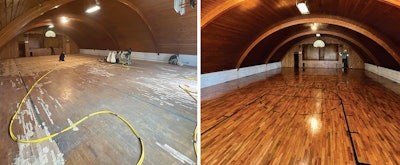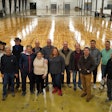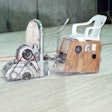
The MFMA (Maple Flooring Manufacturers Association) says that a 25/32-inch (¾-inch) maple gymnasium floor should last 75 years. Their website states: “In 1997, MFMA statistics showed that less than 1 percent of replacement floors were necessitated by depleted wear surface on the existing floor. Floors are far more commonly replaced due to flooding, improper facility maintenance and even building demolition/replacement than are replaced due to the ‘wearing out’ of the surface.”
This has been my experience as well; gym floors are torn out and replaced for reasons other than just having a depleted wear layer. Dead spots and broken boards are much more likely to cause owners to replace their gym floors. There are many examples in this country of 100-plus-year-old gym floors, but they are the exception, not the rule. Like any other product, the longevity of a gym floor will depend on several factors:
1) How well is it cared for?
2) How hard is it used?
3) Has it ever suffered a flood?
4) Is there a good reason to replace it?
Let’s take these one at a time:
1. How well is it cared for?
This is the No. 1 factor. Daily cleaning, yearly maintenance coats, and being sanded every decade or so will keep a gym floor looking like new for generations. A gym floor’s biggest enemy is water, so making sure the facility has a good functional roof is part of gym floor maintenance.
RELATED: What I Learned Going From Residential to Gym Work
Without daily maintenance (see the sidebar on page 34), gym users will continually track dirt and grime around the floor. As a result, the finish will wear off prematurely. If the maintenance coats are also skipped, then the finish may get so worn that the maple itself will be damaged. These poor maintenance procedures will compound upon themselves, and the result will inevitably be a shortened life of the gym floor.
2. How hard is it used?
This seems obvious, but it needs to be pointed out that a K-12 public school that holds physical education classes all day, as well as before-school and after-school sporting activities and community programs, will have a shorter life cycle than a church gym that is used only on the weekends.
3. Has it ever suffered a flood?
Unfortunately, floods are all too common on gym floors, although getting water on your gym floor does not automatically ruin it. Sometimes the spill can be contained and mopped up with little or no damage to the floor. Too often, though, the leak is not immediately detected, and the resulting damage is catastrophic. Many times insurance companies want to try to have a floor/fire restoration company attempt to “dry out” the floor. If the amount of water damage was not severe, this sometimes works. However, if the floor had a significant amount of water standing on it, even when the floor has been “dried out,” issues are possible, if not probable. When plywood or stringers have been soaked with water, as they dry there could be issues with the fasteners not holding as well, which could result in problems with ball bounce, shock absorption, and area deflection.
RELATED: From Start to Finish: How We Did This Gym Floor
A facility owner or manager should be very careful when settling with the insurance company after a flood, and the newer the floor, the more I would recommend total replacement due to the potential for a loss of the expected new-floor performance. Depending upon the quality of the flood mitigation work, a floor that has suffered a flood may have a shortened life cycle.
4. Is there a good reason to replace the floor?
Technology moves ahead, the MFMA member flooring mills have done fabulous work in designing and engineering floor systems that provide athletes with improved safety and excellent biomechanics. The result of the work of sports medicine experts, engineers and basketball programs is that today’s floors offer superior lower extremity (hips, knees, ankles) protection for athletes. Older floors are typically firm—many systems have no padding or pads that have hardened with age. Newer floors provide better shock absorption and vibration control.
Technology in gymnasium floors will continue to improve the performance and safety aspects of the floor systems. As I am writing this, HIC (head injury criterion) specifications are being written, and gym floor designs are being tested with the goal of limiting concussions on maple gym floors. As technological innovations improve gymnasium floor designs, some institutions will elect to upgrade their floor systems, and this will shorten the overall average lifespan of gymnasium floors, particularly competition courts.

























